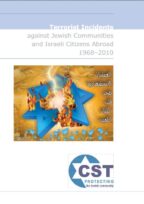Fonte:
www.thecst.org.uk
Summary
During the 43 years since 1968, the
year when Palestinian terror groups
began to attack Jewish and Israeli
targets outside the Middle East, some
427 recorded attacks and foiled or
aborted plots are known to have
taken place.
These 427 actual and foiled terrorist
attacks have included plots by
Palestinian nationalists, neo-Nazis,
radical leftists and, most recently,
both Shiite and Sunni Islamists.
The early 1980s saw the highest
number of attacks, which coincided
with the largest number of terrorist
attacks against all other targets, in
Europe and Latin America. This was
the era of revolutionary Marxist-
Leninist terror groups that evolved out
of the post-1968 New Left movement,
which received help from Soviet Bloc
states and which forged ideological
and tactical alliances with Palestinian
terror groups.
The collapse of the Soviet Bloc and
the signing of the Oslo Accords led
to a dramatic reduction in terrorism
against Jewish and Israeli targets
outside Israel in the second half of
the 1990s. However, the first decade
of the twenty-first century saw the
growth of global jihadi and neo-Nazi
terrorism, replacing old sources
of terrorism with new ones.
There were actual and foiled terrorist
attacks on Jews and Israelis abroad
in a total of 57 countries outside
Israel. The countries with the
highest number of attacks were
France (51 attacks); the United
States (34 attacks); Italy (33 attacks),
Argentina and Germany (29 attacks
in each).
Since 2000, the countries with the
highest number of attacks, both
successful and foiled, have been the
United States (eight attacks), Morocco
(five attacks), the United Kingdom (five
attacks) and Germany (four attacks).
Jewish communities were the target of
250 attacks or foiled attacks, whereas
Israel-linked institutions and individuals
were the target in 189 cases. Of the
250 attacks on Jewish communities,
Jewish community buildings,
organisations and events were the most
frequently attacked (96 incidents).
Synagogues were the targets of 88
actual and attempted terrorist attacks,
while Jewish schools were targets on
16 occasions.
The organisations responsible for
the largest numbers of attacks, both
successful and foiled, during the period
covered by the report are the Palestine
Liberation Organisation (PLO) and its
various affiliates, with 35 attacks;
the Popular Front for the Liberation
of Palestine (PFLP), with 31 attacks;
Abu Nidal’s Fatah Revolutionary Council
(FRC, 24 attacks); Al-Qaeda and its
affiliates (19 attacks); and Hizbollah
(14 attacks).
A total of 208 incidents involved
bombings and employed improvised
explosive devices of all kinds;
76 incidents involved shootings;
while 27 incidents involved letter or
parcel bombs. These are the normal
modus operandi of sub-state actors.
Twelve attacks involved vehicle-borne
bombs and seven plots involved
suicide bombers. In 80 cases, attacks
were interdicted by the authorities,
aborted or otherwise foiled during
the planning stages.
The early years of the period covered
in this report were characterised by
shootings and the use of improvised
explosive devices delivered to
buildings as letter or parcel bombs;
the intermediate years by car bombs;
and the latter years by suicide
bombings. This reflects the change
from far-left and far-right terrorism,
through secular Palestinian terrorism,
to global jihad movement terrorism.
A new terrorist method, which emerged
with the 2008 Mumbai attacks, was
that of multiple-site armed attacks by
small groups, known as ‘swarming’.
Information subsequently made public
suggests that the global jihad
movement is increasingly inclined to
adopt this strategy, which relies on
self-radicalised small groups who may
not have undergone extensive training
by Al-Qaeda and its affiliates.
Far-right, ‘lone wolf’ activists are
increasingly resorting to terrorism in
Europe and the USA under the influence
of the leaderless resistance model.


